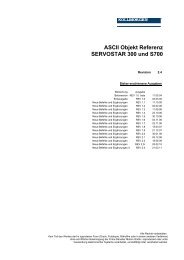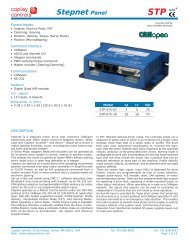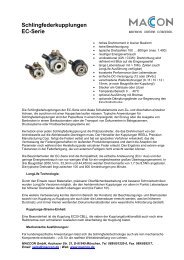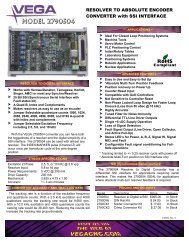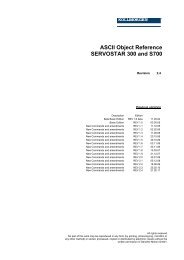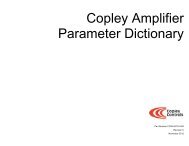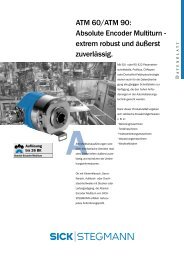CANopen Programmer's Manual - Maccon.de
CANopen Programmer's Manual - Maccon.de
CANopen Programmer's Manual - Maccon.de
You also want an ePaper? Increase the reach of your titles
YUMPU automatically turns print PDFs into web optimized ePapers that Google loves.
<strong>CANopen</strong> Programmer’s <strong>Manual</strong> 4: Control Loop Configuration<br />
Position Loop Inputs<br />
Inputs from the trajectory generator to the position loop are <strong>de</strong>scribed below.<br />
Input Object Name/ID Description Page #<br />
Instantaneous Comman<strong>de</strong>d Velocity to which the position loop's velocity feed forward gain is 137<br />
Velocity / 0x2250<br />
applied.<br />
Instantaneous Comman<strong>de</strong>d<br />
Acceleration / 0x2251<br />
Position Command Value /<br />
0x6062<br />
Acceleration to which the position loop's acceleration feed forward gain<br />
is applied.<br />
Motor position (in units of counts) to which the amplifier is currently<br />
trying to move the axis.<br />
Position Loop Feedback<br />
The feedback to the loop is the actual motor position, obtained from a position sensor attached to<br />
the motor (most often a quadrature enco<strong>de</strong>r). This is provi<strong>de</strong>d by Position Actual Value object<br />
(in<strong>de</strong>x 0x6063, p. 137).<br />
Position Loop Gains<br />
The following gains are used by the position loop to calculate the output value:<br />
Gain Description<br />
Pp - Position loop proportional The loop calculates its Position Error (in<strong>de</strong>x 0x60F4, p. 139) as the difference<br />
between the Position Actual Value and the Position Command Value. This error in<br />
turn is multiplied by the proportional gain value. The primary effect of this gain is to<br />
reduce the following error.<br />
Vff - Velocity feed forward The value of the Instantaneous Comman<strong>de</strong>d Velocity object is multiplied by this<br />
value. The primary effect of this gain is to <strong>de</strong>crease following error during constant<br />
velocity.<br />
Aff - Acceleration feed forward The value of the Instantaneous Comman<strong>de</strong>d Acceleration object is multiplied by<br />
this value. The primary effect of this gain is to <strong>de</strong>crease following error during<br />
acceleration and <strong>de</strong>celeration.<br />
These gains are accessed through the sub-in<strong>de</strong>x objects of the Position Loop Gains object (in<strong>de</strong>x<br />
0x2382, sub-in<strong>de</strong>x 1-6, p. 139).<br />
Position Loop Output<br />
The output of the position loop is a velocity value that is fed to the velocity loop as a command<br />
input. This output is associated with two objects, as <strong>de</strong>scribed below.<br />
Output Object Name/ID Description Page #<br />
Velocity Command Value / Velocity that the velocity loop is currently trying to attain. In normal 144<br />
0x606B<br />
operation, this value is provi<strong>de</strong>d by the position loop and is i<strong>de</strong>ntical to<br />
the Position loop control effort.<br />
Position Loop Control Effort /<br />
In<strong>de</strong>x 0x60FA<br />
Optionally, the velocity loop can be controlled by one of several<br />
alternate control sources. In this case, the Velocity command value<br />
comes from the analog reference input, the digital PWM inputs, or the<br />
internal function generator.<br />
Normally, this value is provi<strong>de</strong>d by the position loop. When the velocity<br />
loop is driven by an alternate control source, the Position loop control<br />
effort object does not hold a meaningful value.<br />
Modulo Count (Position Wrap)<br />
The position variable cannot increase in<strong>de</strong>finitely. After reaching a certain value the variable rolls<br />
back. This type of counting is called modulo count. See bit 21 of the Manufacturer Status Register<br />
object (in<strong>de</strong>x 0x1002, p. 60).<br />
Copley Controls 131<br />
137<br />
137<br />
139




